Could there be anything new to say about urban ruins? For centuries, theorists and philosophers have offered pointed meditations on ruins, their complex and compound temporalities, their alternating propensity toward the sublime and kitsch, their implications for the coexistence of nature and “man,” and much more. The topic has been equally enduring in architectural discourse. From Piranesi’s seminal etchings of crumbled Roman grandeur to postmodern architects’ evocations of ruin in a broad range of projects, reflections on ruins have repeatedly been used to buttress definitions of the discipline in support of architectural endeavor.1 Perpetually teetering on the precipice of evanescence, ruins just won’t go away. And just as ruins continually elicit fascination, a recent cultural coinage may warrant another round of theorization. This is an essay about images of urban ruination, “ruin porn.” Today’s media culture produces ruin porn at a fever pitch, serving up ever-more patinated confections to click-happy audiences. The impact of the Great Recession on America’s declining Rust Belt cities fueled the fire, and media outlets from the New York Times to the Huffington Post to BuzzFeed have basked in its glow.2 While many critics are quick to condemn ruin porn for its regressive aesthetic and ethical transgressions, complex and nuanced relationships between urban ruins, their own mediation, and contemporary urbanity underlie the ubiquity of this type of imagery in today’s media ecology. What follows probes these relationships, arguing for the potential significance of ruin porn for contemporary architectural sensibilities.
1. Ruin porn is aptly named.
While the term seems to have emerged spontaneously from the hive mind of the blogosphere, it communicates the essence of these images with precision. Ruin porn elicits a mixture of immediate visual pleasure and lingering ethical guilt. The superficial subjectivities of contemporary culture find scopophilic delight in images of lapsed working-class urbanity emerging through the crumbling remains of Fordism. Such remains elicit narratives of bygone urban life that seem so authentic, so real, to the white-collar postmodern audience. Sitting on a couch or in a cubicle, ruin porn drives punctum (to use a term favored by Roland Barthes) through the boredom of perpetual comfort.3 Meanwhile the ruins depicted are viewed in the process of being overrun by returning nature, as stone and steel intertwine with encroaching weeds, mold, and wildlife. The viewer is met with paired seductions of authenticity, complexly woven together. Desire for a latter-day, authentic urbanity is interspersed with an equally powerful desire for an organic authenticity, the triumph of nature over human creation. The titillation these images induce might be tempered by simultaneous and sober reflection on capital’s broken contract with the public of urban-industrial America. Gazing at screen or page, we’re all voyeurs, as a disenfranchised urban populace is metaphorically fucked. Images of the city’s bondage-in-rust ought to prompt some remorse as we submit to their unrelenting allure.
Such allure might recall philosopher Slavoj Zizek’s analysis of the seductions of the Lacanian real—a deeply profound and ultimately unattainable authenticity for which we fruitlessly yearn.4 Zizek explains that our cultural fascination with the real is reflected in media that present the aestheticized “effect of the real” to eager audiences. Thus, the popularity of topics like war, death, Armageddon, and natural disaster in movies and on television arises from our yearning to experience profound authenticity. These two points are intricately intertwined. As the tumult of the twentieth century forced us into direct confrontation with the real through war, social unrest, and terrorism, we could not integrate it into our conscious reality and are tragically destined to sublimate desire for the real into desire for its own effect—the aestheticized portrayal of the real in media. This results in a bitter tautology, as the aestheticized “effect of the real” fails to sate our desires, making our impulse to experience profound authenticity ever more fervent. Thus, the desire piqued by viewing ruin porn only fuels desire for more ruin porn.
2. Ruin porn anticipates its own mediation.
Zizek’s caution is uniquely germane to this discussion, as ruins are complexly related to their own aestheticized effect in media. Ruins are both media content and medium, and they powerfully anticipate their own dissemination as image in film and photography. The latter derives from the indexical nature of filmic media, as described by theorists such as Andres Bazin, Siegfried Kracuaer, and Roland Barthes.5 Unlike symbols and icons—semiotic categories that communicate by means of prior knowledge or resemblance, respectively—indexes signify through physical traces of their referents. Film and photography are therefore indexical in their very ontology, in their chemical essence. They come into being as light bouncing off an object of study imprints itself on a photographic medium. Roland Barthes noted that “in Photography I can never deny that the thing has been there,” arguing that the indexical nature of film provides a direct connection to the referent, to reality as such, unencumbered by cultural contingency.6 This indexical nature charges film and photography with complex temporal qualities. Filmic media registers traces of past events and past presences that are then reproduced in another time and place.7
Ruins are similarly indexical.8 With architectural media of crumbled masonry, peeling paint, and encroaching rust, they vividly signify bygone events and past wholes. This capacity to register and re-present time is at the root of the nostalgic response that many have to ruins.9 A photograph of a ruin is therefore doubly indexical—an index of an index. Ruin porn therefore constitutes a cycle of sign-cum-referent that captures compound temporalities and events—from the “slice of time” in which the image was taken, to the duration signified by the depicted decay—within images rich in semiotic potential.10 This doubly indexical nature of ruin porn might have compelling consequences for their architectural objects of study—for the ability of the structures depicted to signify, to communicate, to assume meaning.
3. Ruin porn might not be all bad.
It is through this potential significance for the representational capacities of architecture that we might find some redeeming possibilities for ruin porn. The most frequent criticisms of ruin porn have already been mentioned: some critics deride its propensity to aesthetically obfuscate or erase the political and economic context that surrounds a given architectural object while others condemn it on aesthetic grounds—as kitsch or as a regressive pop confection. Both of these points are sound. But it may be that in dismissing ruin porn we forfeit the opportunity to learn from its popularity.
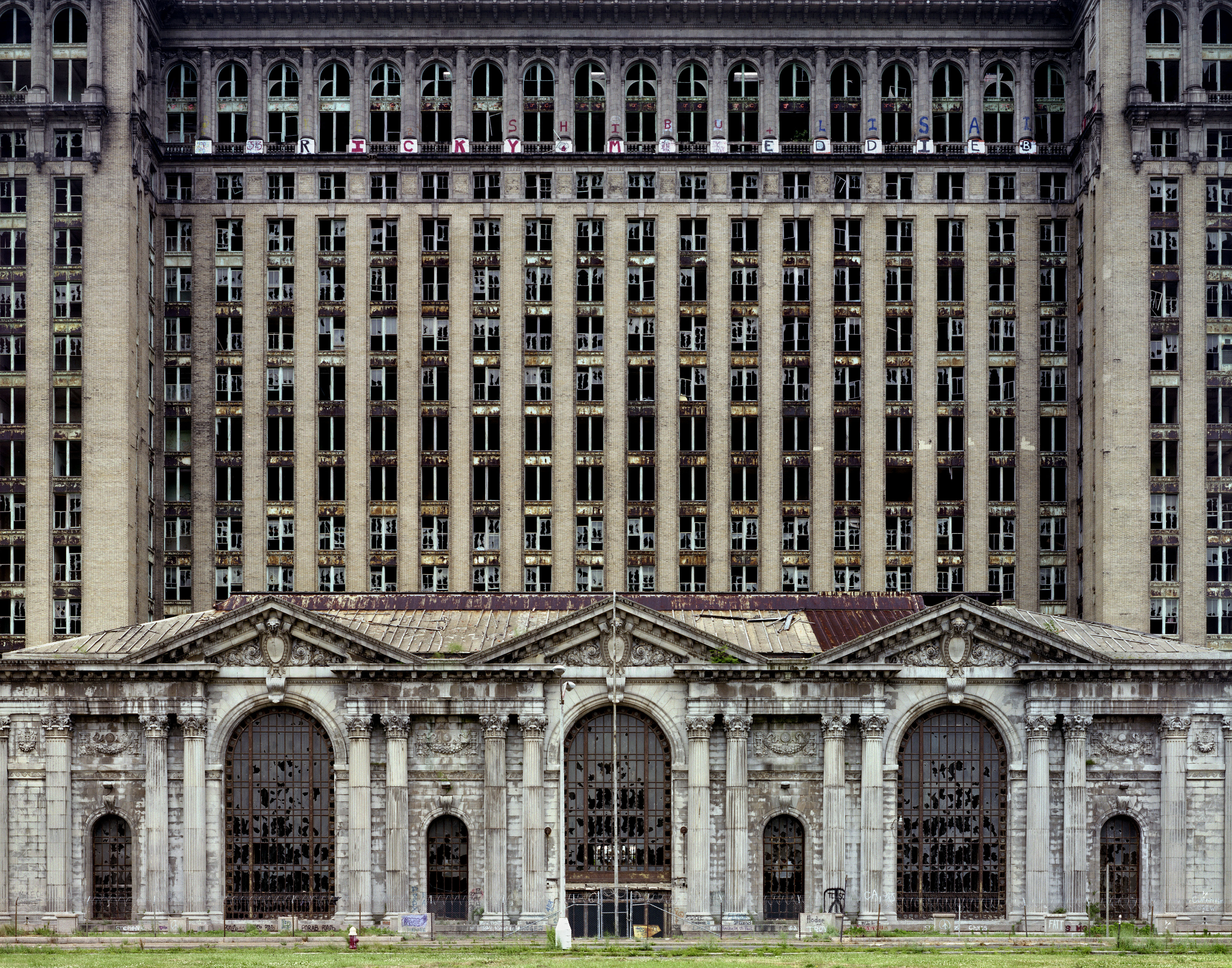
Take Detroit’s Michigan Central Station, undoubtedly one of the most popular subjects of ruin porn in the past decade. Completed in 1913 as the main passenger rail station for what was then a booming industrial center, its halls were built to accommodate a massive flow of rail passengers that has long since vanished. The building was designed in the Beaux-Arts tradition, the prevailing style of public architecture at the time. Accordingly, the station is replete with columns, cornices, ornament, and entablature—elements meant to communicate to the public, reinforce cultural mores, and register a definition of common understanding. It could be claimed that the closure of the station in 1988 after decades of dwindling ridership also signaled the end of the structure’s intended representational project. The building’s communicative posturing no longer amassed an audience. The structure sat unused and unattended for more than a decade, falling into disrepair; only with the circulation of images of its decline did Michigan Central Station find a new audience. Now tourists, suburbanites, and urban wanderers can be found daily gazing at the evacuated husk of the building, capturing photographic evidence of its decay. We might see this phenomenon as a kind of representational blooming—a semiotic spring following the structure’s long winter, somehow brokered through the doubly indexical nature of its filmic representation. Recalling the capacities of indexes to represent reality as such, as described by Barthes, Bazin, and others, and recalling Zizek’s description of desire for the real within contemporary culture, we might conclude that ruin porn compels its audience to seek a heightened level of reality in the structures depicted—a desired real that is perhaps insatiable but nonetheless actively engages spectators. In this process of transference, a quality unique to the image is sought in its referent. Instead of so quickly condemning ruin porn, our discipline might exploit this transference, leveraging and manipulating ruin porn’s capacity to draw audiences to urban environments that have long since lapsed into virtual invisibility.
4. Ruin porn identifies the becoming-affective as an aesthetic category.
The surging audience for ruin porn is witness to a complexly heterogeneous aesthetic form. Reflecting on the ruins born of the onslaught of early modernity, sociologist Georg Simmel observed an antagonistic relationship between architecture and decay that nevertheless resolved with aesthetic coherence. Simmel wrote: “The ruin of a building … means that where the work of art is dying, other forces and forms, those of nature, have grown; and that out of what of art still lives in the ruin and what of nature already lives in it, there has emerged a new whole, a characteristic unity.”11 In the discourse between architectural remains and the onslaught of “nature,” a new and transcendent formal whole emerged from the relationship between the parts.12 Simmel goes on to explain that in one’s aesthetic apprehension of the ruin “there is no longer any sharp division between perception and thought.”13 Hence for Simmel, within the ruin the sensate and the cognitive find a medium of interplay; a new formal whole is realized at the collusion of what can be felt and what can be understood. But in Simmel’s own words, it seems this new whole is constituted less in the ruins themselves than in some impression that ruins evince. Seemingly anticipating the format of contemporary ruin porn, Simmel wrote, “This antagonism … nevertheless offers us a quietly abiding image, secure in its form.”14 Critically, even in the early years of photography and film the appearance of the urban ruin found formal unity within its imagistic quality.
Through Simmel, we can clarify ruin porn’s precise mode of aesthetic address. If its appeal to our desire for authenticity is rooted in a prelinguistic, affective passion (one sensed or felt more than it is understood), and if ruin porn’s doubly indexical nature is testament to its inherent semiotic qualities (its ability to communicate understanding or thought), then it would seem that ruin porn is caught between these two disparate aesthetic registers. In the interplay between the affective and the semiotic, we might find a contemporary example of the antagonistic unity described by Simmel. As in the deterioration of Michigan Central Station’s Beaux-Arts elements, ruin porn inaugurates a new formal whole from the affective decay of semiotic objects. Ruin porn constitutes the arrested image of the becoming-affective.
5. The becoming-affective is everywhere.
Ruin porn shares its particular mode of aesthetic address with a broad array of contemporary design. Through the category of ruin porn—so often seen as inimical to architectural production—we might illuminate certain sensibilities that seem to underlie today’s architectural subconscious.
Beginning with the obvious, New York’s High Line is the most famous occupiable piece of ruin porn, and the cultural sensation that it has become is undoubtedly indebted to the desire for authenticity discussed above. There, rails, pavers, and plantings entice the park’s occupants to read a simulated narrative of abandonment and entropy. Pieces of rusted rail appear as suggestive indexes of urban history that are variably revealed and hidden within vegetation while the tapering paving pattern fictionalizes its own decay and gradual usurpation by natural processes. As in so many examples of ruin porn, semblances of a latter-day industrial urbanity and the organic are richly interlaced.
Significantly, the mediatic nature of the High Line was preordained. Photographer Joel Sternfeld’s images from 2000, capturing the arrested intercourse between the industrial and the organic on the abandoned High Line as found, were deeply effective in garnering public interest in the project. Comparing Sternfeld’s photographs to Iwan Baan’s widely circulated images of the completed park, one might conclude that the Sternfeld series constituted a catalog of effects for the realized design. Visiting today, one finds hordes of apparently somnambulist occupants, chasing carrots at eternal stick’s length, driven to walk ever farther upon the line in search of some anticipated authenticity that never quite coalesces.
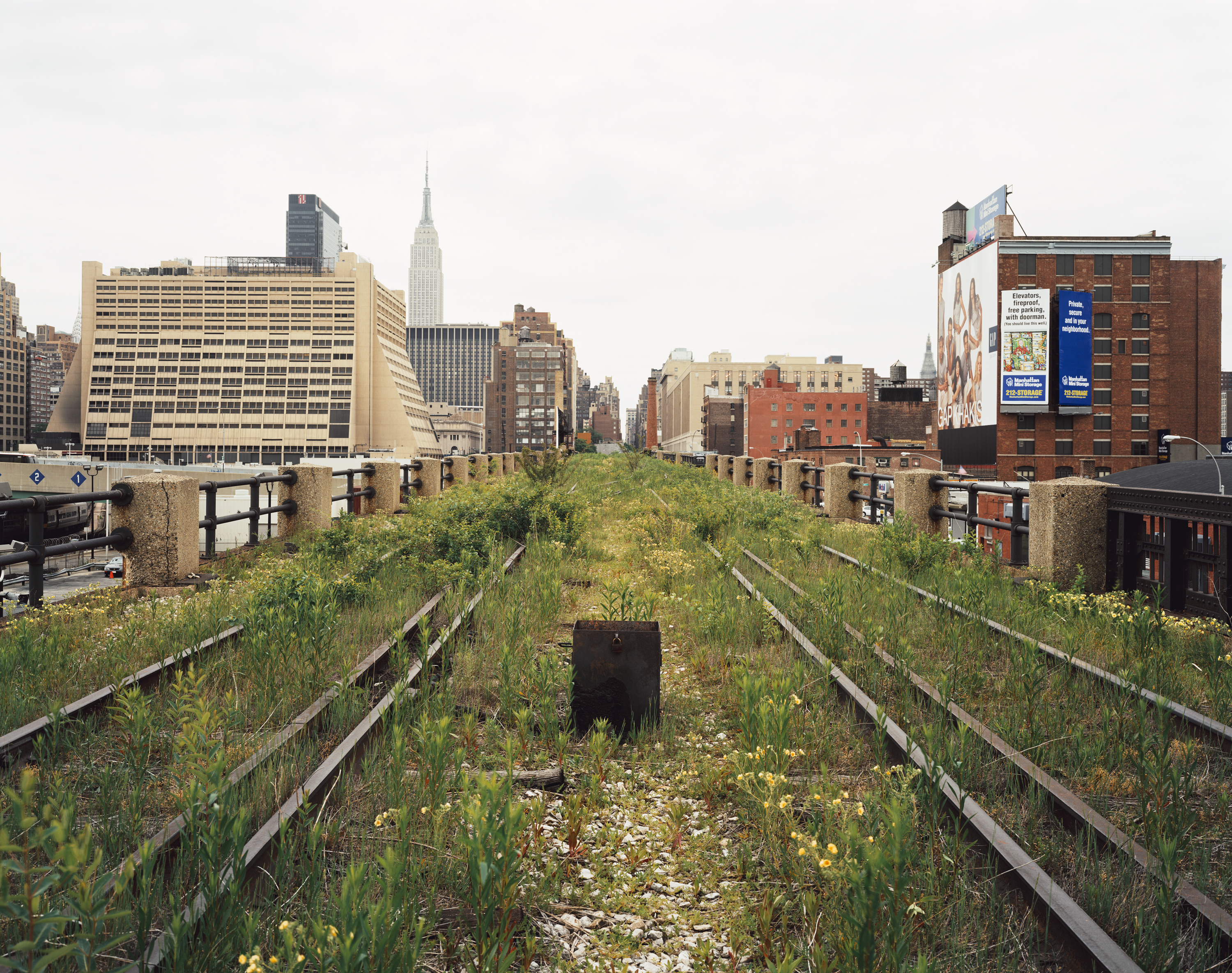
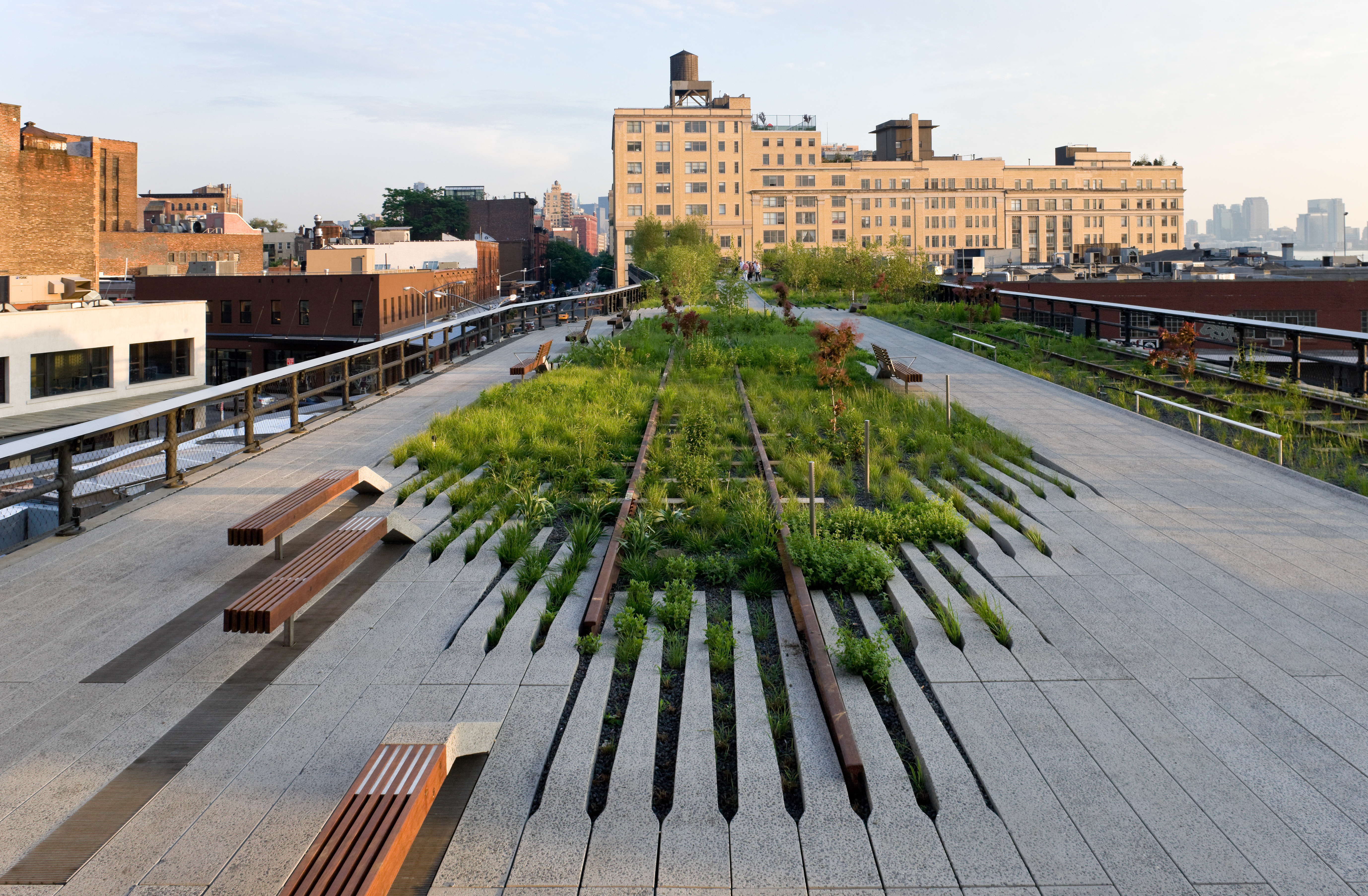
Departing from the obvious, we might find echoes of ruin porn’s interplay between the affective and the communicative lingering in less expected locales, where ruin exists on the level of allusion, or aesthetic sensibility. Training Wheels, David Eskenazi’s 2015 installation at Ohio State University’s Knowlton School of Architecture, is a collection of enormous cardboard wheels crammed into a small gallery. While one might surmise an immediate likeness to a toppled column, the project more precisely evinces the aesthetic sensibility of ruin porn in its games with the legibility of the parts and their relationship to the whole.
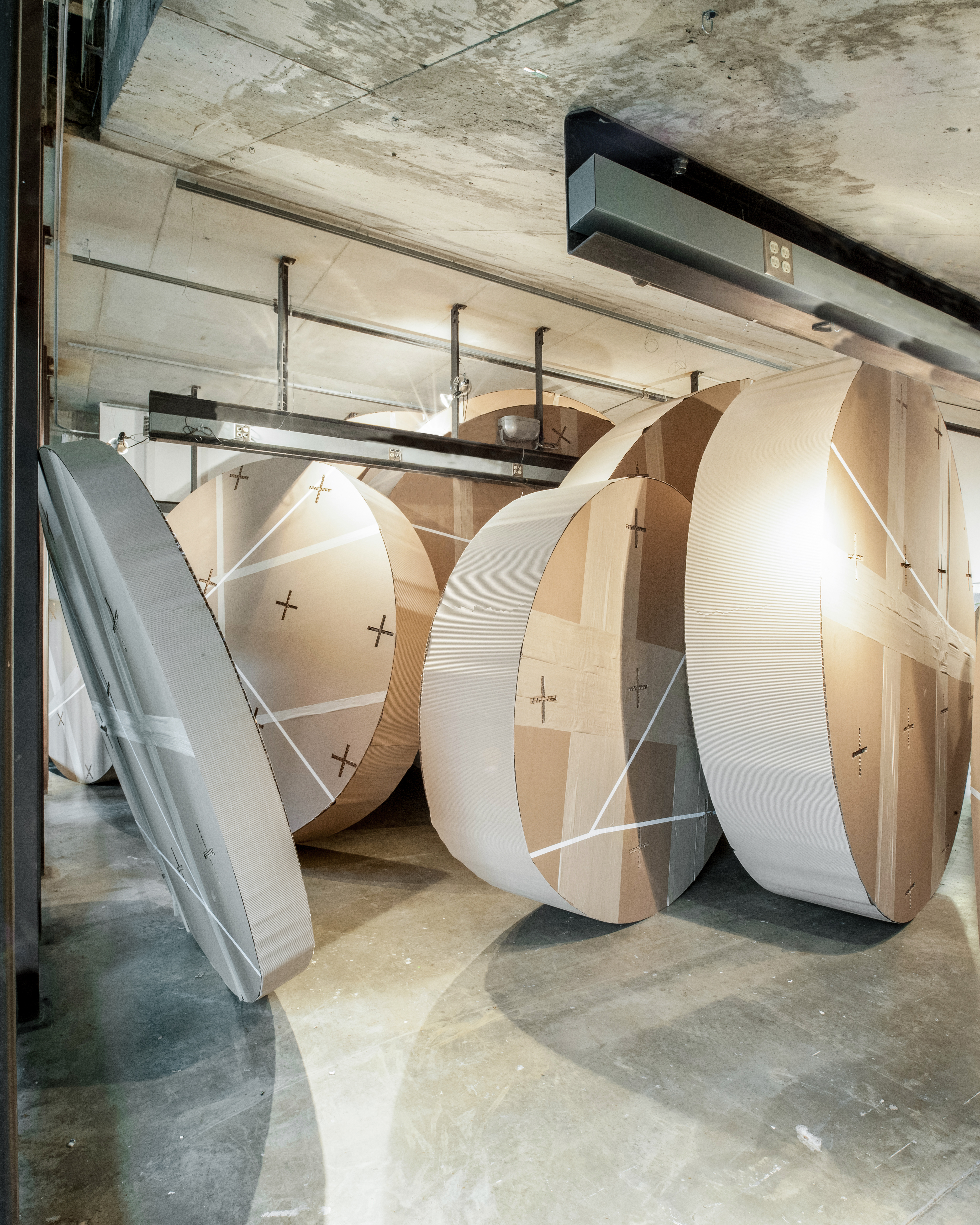
The claustrophobic organization of elements often reveals just enough of each circular profile to frustrate understanding its extent, and the wheels are each adorned with pluses and grids—semiotic elements without apparent referent—seemingly present only to prompt fruitless readership. Meanwhile, each ostensible circle struggles to be so. More Paleolithic than precise, the wheels are lazy approximations of their ideals. Their slack adds affective attitude to semiotic play. The viewer is left struggling to surmise cohesion between parts arranged with indifference, while those same parts broadcast signals for a unity they never provide. A stroll around and between provides no more clarity. Dislocating scalar games abound, and by bumping a wheel one might add motion to the mix, confusing up and down and creating a weak vertigo that is also “vertigo.” That is, the project might thinly provide the affect, while its didacticism is clearly invested in communicating the concept. As in ruin porn, the communicative and the affective complexly collude.
Perhaps the most prominent recent project that bears out the arguments in this discussion is the Detroit Reassembly Plant by T+E+A+M, a collaboration between Thom Moran, Ellie Abrons, Adam Fure, and Meredith Miller (colleagues of mine at the University of Michigan Taubman College of Architecture and Urban Planning). The project was designed for the United States Pavilion at the 2016 Venice Architecture Biennale as part of the exhibition The Architectural Imagination, curated by Cynthia Davidson and Monica Ponce de Leon. The Architectural Imagination included “new speculative architectural projects designed for specific sites in Detroit but with far-reaching applications for cities around the world.”15 Participants were assigned sites in Detroit, but program and particulars were left to the discretion of the designers.
T+E+A+M’s Detroit Reassembly Plant occupies the Packard Plant, one of Detroit’s most famous and widely photographed ruins. The project is conceived as a kind of recycling facility in which disused materials from around the city would be combined with the crumbled ruins of the Packard to form building components for the structure itself. T+E+A+M’s commitment to recasting the physical substance of the city aligns compellingly with many of the points in this essay. In the Detroit Reassembly Plan, the very materiality of the city is collected, aggregated, and reconstituted as immense figural masonry elements. The pieces are then locked into one another to compose a purposely inexplicable tableau. We get a closely packed assemblage of apparent letters, an invitation to extract meaning, but no clues to assist in decoding the cipher. Further, in reconstituting the city’s materials, T+E+A+M seems to have catalyzed their chemical attributes, resulting in various effects of oxidation, patina, and verdigris. Thus, effects evoking the onslaught of nature and decay—familiar from ruin porn and linked to nostalgia and authenticity—are simulated in the constitution of the Detroit Reassembly Plant’s parts. Figural elements seem arrested in perpetual polychrome efflorescence, compounding the semiotic play of the figuration with ingrown indexes of their own chemical emergence while creating an atmosphere of entropy.
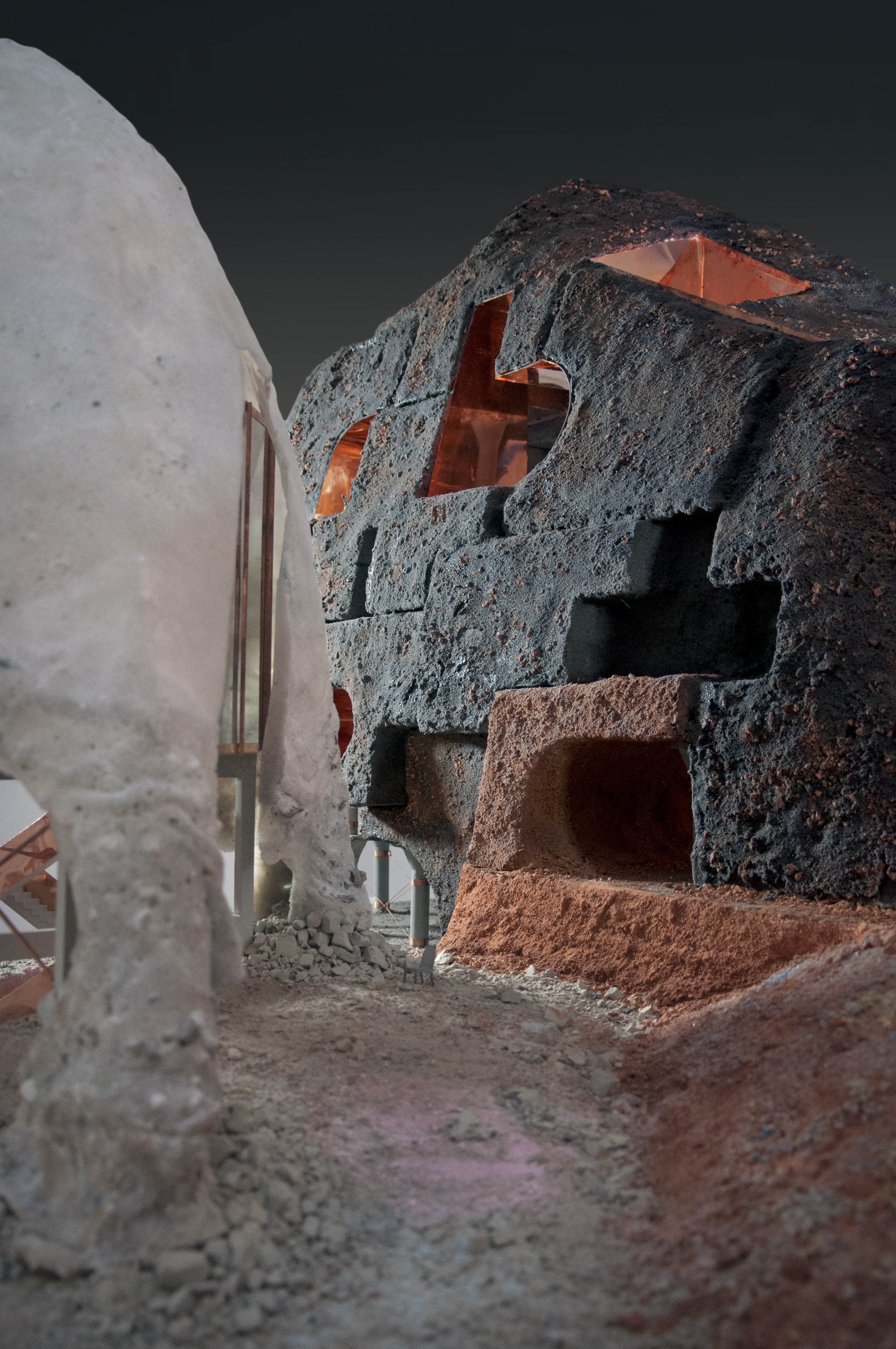
T+E+A+M’s images are digitally assembled combinations of photographed material experiments, renderings with purposefully flat mapping, and self-consciously digital effects. This results in representations that cunningly confuse any distinction between the photographed materials and digitally produced image. Indeed, here the city’s material reality seems to exist only to be converted into imagistic impression. Confirming this inherently mediatic quality of their work, T+E+A+M states: “Detroit doesn’t have a material problem; its material has an image problem.”16 In manipulating the aesthetics of urban decay, T+E+A+M knowingly produces a project native to the very same media culture that has afforded ruin porn its recent prominence. In this sense, we might read into the project a trajectory toward the redemption of ruin porn—an attempt to co-opt the form and redirect it away from its conventional narrative of decline and toward narratives of urban resurgence in which Detroit’s ostensible depravity is traded for a rich aesthetic abundance.17
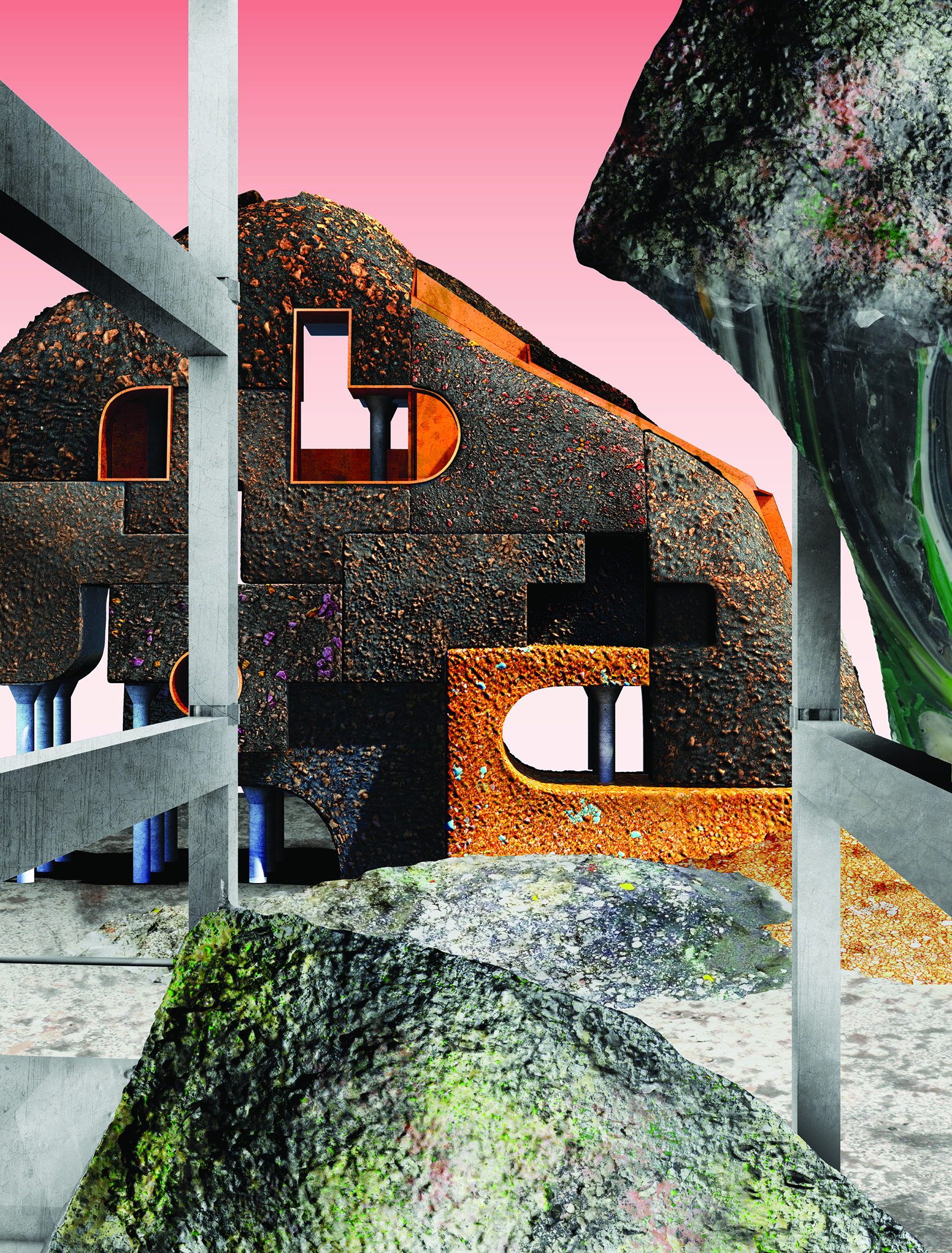
If there is any promise in ruin porn, it emanates from its ability to gather an audience where there was previously none. Despite ethical transgressions, despite sometimes-kitsch aesthetics, ruin porn has turned eyes to cities in decline in volumes unseen in the latter half of the twentieth century. Regardless of whether these gazes seek authenticity, nostalgia, or some other libidinal urge, it seems the role of architecture might be to turn these spectators into citizens. Viewed in this light, our discipline might mine ruin porn. In these images we can perhaps find aesthetic qualities uniquely fit to redress the representational capacities of civic architecture, consolidating a public for whom urban reality and urban mediation are complexly intertwined.
-
For one treatment of the presence of ruin in postmodern architecture, and its significance to the definition of the discipline at that moment, see John McMorrough, “Ru(m)inations: The Haunts of Contemporary Architecture,” Perspecta 40: Monster (2008): 164–169. I am thankful to John McMorrough for reading and commenting on an early draft of this essay. ↩
-
For example: “Wringing Art Out of the Rubble in Detroit,” New York Times, August 3, 2010. See also link and link. ↩
-
See also Eric Jaffe, “Six Scientific Reasons You Can’t Stop Looking at Ruin Porn,” Fast Company, July 18, 2014, link. ↩
-
Slavoj Zizek, The Sublime Object of Ideology (London: Verso, 1989), 3, 47–49. ↩
-
See, for example, Andres Bazin, “The Ontology of the Photographic Image,” What Is Cinema?, trans. Hugh Gray (Berkeley: University of California Press, 1972), 9–16; Siegfried Kracauer, Theory of Film: The Redemption of Physical Reality (New York: Oxford University Press, 1960); Roland Barthes, Camera Lucida: Reflections on Photography (New York: Farrar, Straus and Giroux, 1981). All of these figures are considered realist theorists of film and photography, and while all do not necessarily use the word “index” in their texts, their work is widely associated with the term. ↩
-
Barthes, Camera Lucida, 76. ↩
-
To this point, Barthes wrote, “The Photograph does not call up the past (nothing Proustian in a photograph). The effect it produces upon me is not to restore what has been abolished (by time, by distance) but to attest that what I see has indeed existed.” Barthes, Camera Lucida, 82. ↩
-
Film historian and theorist Johannes Von Moltke has previously aligned filmic media and ruins based on their shared indexical nature. See Johannes Von Moltke, “Ruin Cinema,” in Ruins of Modernity, ed. Julia Hell and Andreas Schonle (Durham and London: Duke University Press, 2010), 395–417. ↩
-
For one recent discussion of ruins and nostalgia, see Svetlana Boym, “Tatlin, or, Ruinophilia,” Cabinet 28 (Winter 2007–2008). ↩
-
This phrase was made famous by Susan Sontag in her essay “In Plato’s Cave,” in On Photography (New York: Farrar, Straus and Giroux, 1977), 17. ↩
-
Georg Simmel, “The Ruin,” in Essays on Sociology, Philosophy and Aesthetics, ed. Kurt H. Wolff (New York: Harper & Row, 1965), 260. ↩
-
Here we might understand Simmel’s notion of unity to align with a Kantian aesthetic formalism, as in Kant’s description of the “form of the purposiveness of an object” emerging from “the relation of the representative powers (of an object) to one another…” See Immanuel Kant, Critique of Judgment, Part 1: Critique of Aesthetic Judgment, trans. J. H. Bernard (London: MacMillan and Co. Ltd., 1914), Div. 1, 11. ↩
-
Simmel, “The Ruin,” 266. ↩
-
Simmel, “The Ruin,” 265. Emphasis added. ↩
-
The Architectural Imagination, United States Pavilion for the 2016 Venice Architecture Biennale, link. ↩
-
T+E+A+M, “Detroit Reassembly Plant,” for The Architectural Imagination, United States Pavilion at the 2016 Venice Architecture Biennale, link. Emphasis added. ↩
-
For their part, T+E+A+M expresses this abundance primarily in terms of materials themselves. The state: “Where others see an excess of ruins, we see an abundant resource for building materials.” ↩
McLain Clutter is an architect, author, and associate professor at the University of Michigan Taubman College of Architecture and Urban Planning. Clutter’s work focuses on the role of architecture within the multidisciplinary milieu of contemporary urbanism. His book, Imaginary Apparatus: New York City and Its Mediated Representation, was published by Park Books in 2015. Clutter directs the Ann Arbor–based design practice Master of None.

